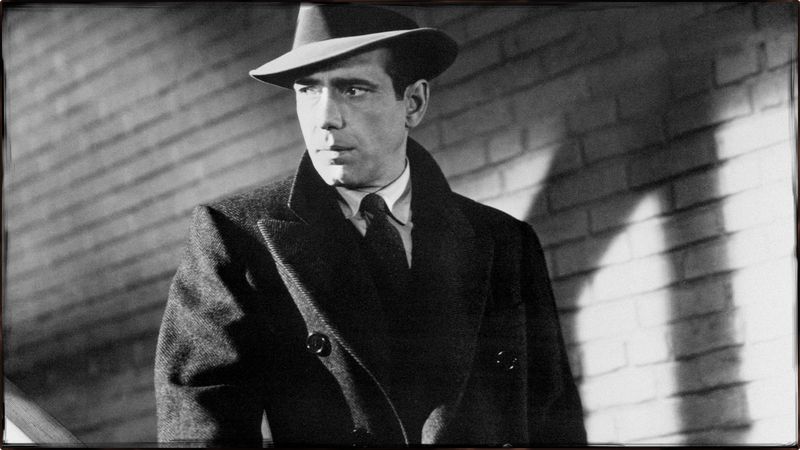THE JOURNAL

Mr Humphrey Bogart in The Maltese Falcon (1941). Photograph by Warner Bros/Landmark Media
Mr Humphrey Bogart played a private investigator in what now seems like 274 different movies. In The Maltese Falcon, he was dashing in regal, shawl-collared trench coats with lapels contoured like rib eyes. His fedora in The Big Sleep took on the dignity of a monument. Throughout, his suits reflected a flawless melding of personal style and personal armour. But his look, and his characters’ surly bearing, created a problem. According to every single PI with whom I’ve spoken, Mr Bogart’s trademark detective look gets it wrong – every single time.
Over the course of researching my new book, Becoming A Private Investigator, which is about the challenges, sacrifices and misunderstandings surrounding the profession, I heard one consistent complaint from PIs all over the country: Hollywood has damaged their image.
In real life, PIs have to dress for their days just like the rest of us, with respect to the actual functions of their job. Think “ghillie” suits: military-grade swamp man or snow-beast get-ups, for surveillance purposes. Blending in is the name of the game. Imagine having to serve legal papers to a meth abuser in the middle of nowhere, dressed in a beautifully tailored, double-breasted pinstriped suit. “You can’t come across like you’re better than anyone,” said one PI. “Just keep it simple.”
It stands to reason, then, that none of the PIs I met identified with Mr Bogart, or with Mr Richard Roundtree’s 1970s sexpot John Shaft. Empathy towards their clients mattered to them far more than being quick to react to an adversary with a back-handed slap. Real PI work takes time (months or years, not an audience-friendly 90 minutes) and head-to-toe leather, or a jaunty hat, doesn’t speed up the process.
That’s not to say these men and women don’t put consideration into their wardrobes. They dress for their investigations mainly to safeguard their own lives. If they’re wearing a suit of the non-ghillie variety, it’s a considered measure, not merely elevated period attire. Take, for example, one PI who ventured to the Middle East in search of a man who claimed to be dead. Once on the ground, he donned a Western-style suit there, hoping, by way of diversion, that it might protect him from the sorts of people who fake their own deaths and those hiding such a man thousands of miles away from home. “They would pause before trying to kill me,” said the PI. The suit, he figured, would buy him critical seconds with which to react, run or start negotiating his survival.
Another PI, a Texan, told me he’d never wear a hat on the job because people needed to see his eyes clearly in order to develop a feeling of trust. Yet another, who works among the rural poor in Appalachia and the American South, talked about the importance of wearing the sorts of things that would draw no attention to himself whatsoever.
“Don’t wear grey, black or red. White is probably a good bet. They won’t shoot at white.”
While reporting a separate story several years back, a subject told me how to dress so as not to put myself in danger. We were in Rio de Janeiro, heading into a favela when rival factions began spraying bullets at each other. “Don’t wear grey, black or red,” my subject said. “White is probably a good bet. They won’t shoot at white.”
Gunfire or not, I’ve always worried about what to wear to work. Writers can’t really look to the movies for guidance, either – unless they want tie knots that bulge like bagels or shirts creased everywhere, accidentally resembling ancient battle maps. Choices like that are alarmingly antithetical to the mission at hand. The point of my work is to leave as much room as possible for subjects to fill in the space of a story. Giving an interlocutor reason to question my trousers would mean I’m doing it all wrong. Reporting is about vanishing in plain sight, much like being a PI.
For years, I have worked on what this means in terms of a look, all the while stressing that I’d fail to construct it correctly. If I dress too casually, will my subject take me for a lightweight? If I look too stiff, will the subject react in kind? Can wearing a tie result in an over-starched shirt of a story? Which clothes are truly the best ones for listening?
Admittedly, I’ve Bogarted my own outfit more than once: overdoing it to the point of feeling costumed rather than clad in anything I might actually look right in. But a year spent among private investigators became an opportunity to drop the anxiety for good and finally focus my work wardrobe, boiling it down to the absolute basics. I’ll save the double-breasted suits and fedoras for special occasions.
The men featured in this story are not associated with and do not endorse MR PORTER or the products shown